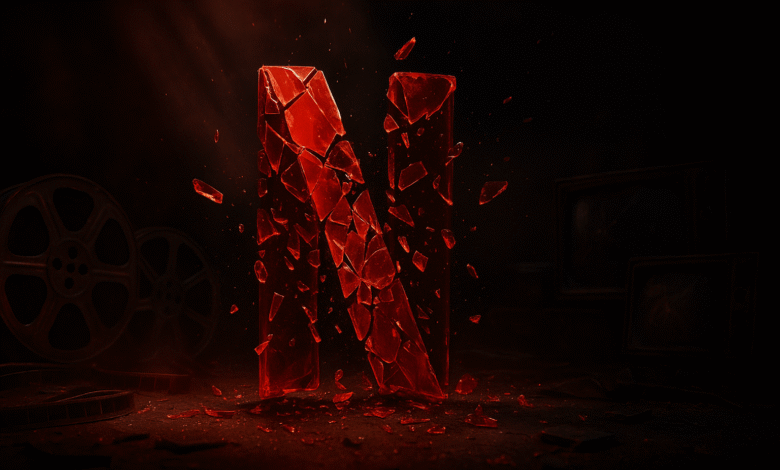The Biggest Netflix Flops of All Time: What Went Wrong?
The biggest Netflix flops offer valuable lessons about what happens when big budgets meet poor execution, when creative vision clashes with audience expectations, and when data-driven decisions go wrong.

Netflix changed how we watch TV and movies. The streaming platform went from mailing DVDs to becoming a global entertainment powerhouse with over 200 million subscribers worldwide. But success hasn’t come without some spectacular failures. For every Stranger Things or Squid Game, there are dozens of expensive Netflix flops that crashed and burned, costing the company hundreds of millions of dollars and damaging its reputation.
The biggest Netflix flops offer valuable lessons about what happens when big budgets meet poor execution, when creative vision clashes with audience expectations, and when data-driven decisions go wrong. These failures span across genres, from historical dramas to superhero shows, from Adam Sandler comedies to anime adaptations. Understanding why these projects failed helps explain the current state of streaming, the pressure on Netflix original series to perform immediately, and why the platform has developed a reputation for canceling shows faster than any other streaming service.
This article examines the most notorious Netflix failures, breaking down the financial losses, creative missteps, and strategic errors that turned high-profile projects into cautionary tales. Whether it’s a $200 million period drama that nobody watched or a superhero show that alienated fans from day one, these Netflix cancellations reveal the harsh realities of the streaming wars.
EXPLORE THE CONTENTS
The $200 Million Disaster: Marco Polo
When discussing Netflix budget losses, one name stands above the rest. Marco Polo wasn’t just a flop. It was the first Netflix Original series to be canceled without renewal, and it reportedly lost the company around $200 million. That’s not a typo. The historical drama about the famous explorer’s time in Kublai Khan’s court cost approximately $90 million just for the first 10 episodes, making it one of the most expensive TV productions ever at the time.
The show premiered in 2014 with high expectations. Netflix wanted its Game of Thrones, a sprawling historical epic that would attract global audiences. The production design was stunning, the battle sequences were impressive, and the setting was visually spectacular. But critics weren’t impressed. Season one received lukewarm reviews, with many finding the storytelling slow and the characters underdeveloped.
Season two improved the quality, but the damage was done. Viewership numbers never justified the massive production costs. The cost-plus model that Netflix uses, where they pay production costs plus a 30% premium, meant that continuing the series became financially impossible. After two seasons, Netflix pulled the plug, making Marco Polo a historic failure in more ways than one.
What went wrong? The show struggled to find its identity. It tried to appeal to both Western audiences unfamiliar with the period and Asian markets that wanted authentic representation. The main character, played by Italian actor Lorenzo Richelmy, felt like an outsider in his own story. The real draw was Benedict Wong’s portrayal of Kublai Khan, but the show’s structure kept Marco Polo at the center. The streaming platform learned an expensive lesson: throwing money at production values doesn’t guarantee success without strong writing and compelling characters.
Adam Sandler’s Western Disaster: The Ridiculous 6
Netflix signed Adam Sandler to a four-movie deal in 2014, betting that his comedy style would translate to streaming success. The first result was The Ridiculous 6, a Western parody that became one of the most controversial Netflix failures in the platform’s history. The film holds an 0% rating on Rotten Tomatoes from critics, though it somehow reached 38% from audiences.
The problems started before filming even finished. Several Native American actors walked off set, citing offensive portrayals and culturally insensitive jokes in the script. The controversy brought negative attention to Netflix’s content strategy and raised questions about quality control for Netflix original movies. Despite being released in late 2015, the backlash continued for months.
Netflix defended the film, claiming it was their most-watched movie ever in its first 30 days. But “most-watched” doesn’t mean good, and the company’s refusal to release actual viewership numbers made those claims impossible to verify. Critics savaged the film for its lazy humor, offensive stereotypes, and two-hour runtime that felt interminable.
The truly baffling part? Netflix extended Sandler’s deal after The Ridiculous 6 and its follow-up flops The Do-Over and Sandy Wexler. The company insisted Sandler’s films performed well in their internal metrics, prioritizing completion rates over critical reception. This decision highlighted a fundamental tension in Netflix’s strategy: do you chase prestige or prioritize content that keeps subscribers from canceling, regardless of quality?
Marvel’s Biggest Mistake: Iron Fist
By the mid-2010s, the Marvel Cinematic Universe seemed unstoppable. Netflix’s partnership with Marvel had already produced well-received shows like Daredevil, Jessica Jones, and Luke Cage. Then came Iron Fist, and the streaming service faced its first major superhero disaster.
The problems began with the casting announcement. Finn Jones, a white British actor, was cast as Danny Rand, a character whose martial arts mastery comes from training in a mystical Asian city. The decision sparked immediate accusations of whitewashing, especially since the character’s comic book origins already contained problematic elements. Instead of updating the story for modern sensibilities, Netflix doubled down on the most controversial aspects.
But the casting wasn’t the only issue. The show itself was poorly executed from start to finish. The fight choreography was embarrassingly weak for a series about a martial arts master. The writing was sluggish, the pacing dragged, and Danny Rand came across as whiny and entitled rather than heroic. Critics destroyed it, and even Marvel fans who had supported the previous Netflix shows turned against Iron Fist.
The show limped through two seasons before cancellation. Netflix eventually canceled all its Marvel shows, partly due to Disney launching its own streaming platform, but Iron Fist’s failure accelerated the end. What went wrong? Netflix rushed production to meet a release deadline, giving the creative team insufficient time for fight choreography and script development. The production costs couldn’t overcome fundamental creative failures.
Anime Adaptation Gone Wrong: Cowboy Bebop
Live-action anime adaptations have an abysmal track record, but Netflix thought they could break the curse with Cowboy Bebop. The original 1998 anime is considered one of the greatest ever made, with a perfect blend of space western aesthetics, jazz music, and philosophical storytelling. Netflix’s 2021 adaptation cost millions and featured John Cho in the lead role as Spike Spiegel.
The show was canceled after just one season, despite decent viewership numbers in its first week. What happened? The adaptation failed to capture what made the original special. It leaned too heavily into camp and self-awareness, undermining the emotional weight of key storylines. The visual style, while expensive, felt more like cosplay than a lived-in universe. Fans of the original anime rejected it, and newcomers found it too weird and disjointed.
Netflix’s approach to Cowboy Bebop revealed a common problem with their adaptations. The company kept interfering with creative decisions, trying to make the story more accessible to mainstream audiences while simultaneously pandering to hardcore fans. The result satisfied neither group. Add in controversial changes to beloved characters and a tone that couldn’t decide if it was serious drama or campy comedy, and you have a recipe for one of the biggest Netflix flops in recent memory.
The cancellation came quickly, faster than most. Netflix announced the decision just three weeks after the show’s release, suggesting the internal metrics were catastrophically bad. For John Cho, who had advocated for more Asian representation in Hollywood, the failure was particularly disappointing.
Also Read: Netflix Hidden Gems: 10 Underrated Series That Deserve Your Attention
The Superhero Show Nobody Wanted: Jupiter’s Legacy
In 2021, Netflix released Jupiter’s Legacy, a superhero series based on Mark Millar’s comic books. The company had purchased Millar’s entire comic book company in 2017, making this adaptation a high-priority project. It should have been a slam dunk: a multi-generational superhero story with family drama, moral conflicts, and spectacular action sequences.
Instead, it became one of the year’s worst Netflix original shows. The series suffered from terrible pacing, with constant flashbacks disrupting the narrative flow. The characters were one-dimensional, the dialogue was wooden, and the action scenes, despite the budget, felt flat and unexciting. Critics panned it, and audience response was lukewarm at best.
Netflix canceled Jupiter’s Legacy after one season, but here’s where it gets interesting. The company announced they were developing a new series set in the same universe, focusing on different characters from Millar’s comics. This decision revealed Netflix’s strategy: when a Netflix original series fails, sometimes it’s better to pivot than to try fixing the problems. The replacement series, Jupiter’s Legacy: Requiem, was also eventually canceled, proving that the IP itself wasn’t the issue—the execution was.
What went wrong? Jupiter’s Legacy tried to be everything at once: a prestige family drama, a superhero action show, and a political commentary. It succeeded at none of these goals. The production costs kept climbing while the creative vision remained muddled. Netflix learned that recognizable source material and a big budget don’t guarantee success.
Video Game Adaptation Disaster: Resident Evil
Netflix has struggled with video game adaptations, and the 2022 Resident Evil series stands as one of the most spectacular failures. The horror franchise has massive global recognition, and Netflix attempted to create a new story that honored the games while telling something original. The result was a show that alienated both fans of the games and general audiences.
The series featured Lance Reddick in his final television role and attempted to split the narrative between two timelines. Critics and viewers hated it. The writing felt uninspired, the scares were predictable, and the connection to the beloved game franchise felt superficial. Worse, the show made creative choices that contradicted established lore, frustrating longtime fans.
Netflix canceled Resident Evil after just eight episodes, making it one of the fastest Netflix cancellations for a high-profile project. The viewership numbers dropped dramatically after the first weekend, and social media response was overwhelmingly negative. What went wrong? The show tried to appeal to too many audiences simultaneously: horror fans, video game enthusiasts, teen drama viewers, and Netflix’s general subscriber base. The result satisfied none of these groups.
The failure of Resident Evil highlighted Netflix’s ongoing struggle with established franchises. When you adapt beloved properties, you’re fighting an uphill battle against expectations. Netflix’s tendency to add unnecessary subplots, change core elements, and prioritize their house style over the source material has resulted in multiple Netflix flops across different genres.
The Musical That Bankrupted Cool: The Get Down
Baz Luhrmann’s The Get Down should have been a cultural phenomenon. The musical drama about the birth of hip-hop in 1970s Bronx had everything going for it: a visionary director, a compelling premise, a diverse cast, and Netflix’s full financial backing. The first season cost approximately $120 million for just 12 episodes, making it one of the most expensive Netflix original series ever produced.
The show premiered in 2016 to mixed reviews. Critics praised the ambition and visual style but criticized the pacing and narrative structure. The music was spectacular, the performances were solid, and the production design was immaculate. But audiences didn’t show up in the numbers Netflix needed to justify the enormous budget.
After the first season’s lukewarm reception, Netflix cut the second season order from 13 episodes to just six. Those six episodes served as a rushed conclusion to the story, and then The Get Down was over. The cancellation shocked many in the industry. Here was a show that represented exactly what streaming could be: ambitious, expensive, artistically bold. But the economics didn’t work.
What went wrong? The Get Down suffered from behind-the-scenes production chaos. Luhrmann’s perfectionism led to budget overruns and delays. The show’s split focus, between musical performances and dramatic storylines, meant it never found a clear identity. And Netflix’s metrics-driven approach to renewals meant that even critically acclaimed shows face cancellation if the viewership numbers don’t justify the production costs. The Get Down proved that even A-list talent and unlimited budgets can’t save a show that audiences don’t watch.
Recent Catastrophes: The Electric State and Beyond
Netflix’s most recent major flop shows the company hasn’t learned from past mistakes. The Electric State, directed by the Russo Brothers (Avengers: Endgame) and starring Millie Bobby Brown and Chris Pratt, reportedly cost over $300 million to produce. When it released in early 2025, critics savaged it, giving it a 15-17% rating on Rotten Tomatoes.
The film represents everything wrong with Netflix’s blockbuster strategy. Despite enormous production costs and A-list talent, The Electric State felt soulless and derivative. Critics called it “dumb” and “uninspired,” comparing it unfavorably to better films in the sci-fi genre. Viewership dropped quickly after the first week, suggesting that even Netflix subscribers weren’t interested in watching it all the way through.
This failure is part of a pattern. Netflix’s most expensive movies, including Red Notice, The Gray Man, and 6 Underground, have all received poor critical reception despite massive budgets. The company seems to believe that throwing money at big-name actors and directors will automatically create hits, but audiences are increasingly skeptical of Netflix’s “mockbusters”—films that look like theatrical blockbusters but lack the creativity and craftsmanship that make movies memorable.
Other recent Netflix failures include Space Force (canceled after two seasons despite Steve Carell’s star power), Disjointed (a pot comedy that was universally panned), and Hemlock Grove (Eli Roth’s horror series that never lived up to its potential). Each of these shows had different problems, but they share common threads: weak writing, unclear target audiences, and Netflix’s willingness to greenlight projects based on star power rather than strong scripts.
Why Netflix Shows Fail: The Real Problems
Understanding why shows fail requires looking beyond individual creative missteps. Netflix faces structural problems that contribute to these flops. The streaming service operates on a cost-plus model, paying for production plus a 30% premium. This incentivizes studios to inflate budgets, knowing Netflix will cover the costs. As shows continue, costs rise, and renewal becomes less attractive financially.
Netflix’s metrics-driven approach also creates problems. The company measures success primarily through completion rates and subscriber retention, not artistic merit or critical acclaim. A show might be excellent but get canceled because it didn’t attract enough new subscribers or prevent existing ones from leaving. This creates pressure to make immediately accessible content rather than shows that might take time to find their audience.
The platform’s global strategy also backfires sometimes. Netflix tries to create content that works worldwide, but cultural specificity often makes stories more compelling. Shows that try to appeal to everyone frequently end up bland and forgettable. According to Deadline, Netflix’s cancellation strategy has become more aggressive as competition from Disney+, HBO Max, and other platforms intensifies.
Competition is another factor. As Newsweek reports, Netflix must constantly innovate and release new content to stay ahead of rivals. This creates pressure to greenlight risky projects and move quickly, sometimes before scripts are ready or creative teams have gelled. The result is more Netflix flops that could have succeeded with more development time.
What Netflix Could Learn From Its Failures
The biggest Netflix flops offer clear lessons. First, budget size doesn’t correlate with quality. Marco Polo, Jupiter’s Legacy, and The Electric State all had massive budgets but failed because of poor storytelling. Netflix would benefit from investing more in writers and directors rather than just expensive visual effects and big-name actors.
Second, rushing productions leads to failures. Iron Fist suffered from insufficient pre-production time for fight choreography. Cowboy Bebop needed more time to find its tone. The company’s aggressive release schedule creates pressure that undermines creative quality. Better to delay a show than release a flop that damages the brand.
Third, Netflix needs to give shows more time to find audiences. The practice of canceling series after one or two seasons, even successful ones, has created subscriber frustration. Viewers are increasingly reluctant to start new Netflix original series because they assume cancellation is inevitable. This becomes a self-fulfilling prophecy: viewers don’t start shows, viewership numbers suffer, and cancellation follows.
Fourth, adaptations require respecting source material while updating it thoughtfully. The Ridiculous 6’s cultural insensitivity, Resident Evil’s lore contradictions, and Cowboy Bebop’s tonal issues all stemmed from not understanding what made the originals work. Hiring creative teams who genuinely understand and love the source material produces better results than hiring directors based on résumés alone.
Finally, Netflix should prioritize creative vision over data. The platform’s algorithm-driven approach creates homogenous content that feels designed by committee. The shows that succeed—Stranger Things, The Crown, Squid Game—often came from strong creative visions that Netflix supported rather than micromanaged.
The biggest Netflix flops of all time reveal that even streaming giants make expensive mistakes. From the $200 million disaster of Marco Polo to the critically panned Electric State, these failures share common problems: weak storytelling, unclear target audiences, budget overruns, and rushed production schedules. While Netflix has produced some of television’s best content, its aggressive expansion strategy and metrics-driven decision-making have also created spectacular failures.
As streaming competition intensifies, Netflix must learn from these Netflix failures, focusing on quality over quantity, respecting creative processes, and giving shows room to develop audiences. Otherwise, the next generation of expensive flops is already in production, waiting to disappoint subscribers and waste millions.







